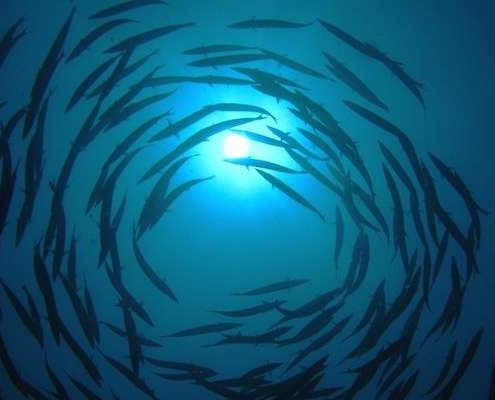The oceans are acidifying at the fastest rate in world history. By the end of the century the oceans will be doomed to revert to slimy premordial conditions, unless we can stop CO2 emissions in the next few decades.
As trends currently stand, by 2100
calcium carbonate will be locked into irrevocably disappearing from the seas. Caused by injection of CO2 into the oceans from the atmosphere, this will erase coral reefs, calcium-shelled large life and plankton, and animals which use calcium carbonate for their internal skeletons.
This acidification is happening terribly quickly. Never before in the history of life on earth have the oceans acidified so much, so quickly. There is no time for life to adapt.
This loss of calcium carbonate-using species will, in turn, punch huge and irreparable holes in existing food webs, throwing the seas into disarray and causing r-type species to displace K-type species.
This means jellyfish, salps, algae, and bacterial slimes will increasingly replace fish, dolphins, whales, seals, and most other advance creatures. It is the rise of slime: the descent of the seas of earth into primordial conditions.
There is no doubt this is occurring. The oceans are already 30% more acidic than they were before humans started burning fossil carbon. They are preducted to be 150% more acidic by the end of the century if we continue business as usual.
This spells the end of modern seas, in favor of slime-and-bacteria primordial seas. Modern K-type sea species we are used to will not survive where those conditions encroach. It is an open question whether humans will survive a world of toxic, slimy seas. It has never occurred while we have existed.
We humans have it backwards. When thinking about CO2 at all, we tend to think about Sea Level Rise, which is about the least-destructive aspect of CO2 forcing. Oh, it will be plenty destructive but it will play out in slow motion. Any snail can out-run sea level rist.
We then think about surface atmospheric heating – as well we might! – because it can burn rainforests, turn cropland to desert, and make much of the world unlivable for humans. Yet we push this out of our minds with debates over 3C degrees warming versus 7C degrees warming and the difficulty of making perfect models of the earth’s atmosphere. And when winter comes, most of us assume that this refutes CO2 heat forcing. Not smart, but very human. Because the change is slow and incremental.
In contrast, hardly anyone but experts and marine biologists are even aware of ocean acidification, yet is is the most immediately apocalyptic aspect of flooding the biosphere with CO2.
We have ALREADY injected sufficient CO2 to kill off and dissolve huge amounts of coral reef, and at the poles, the shells of plankton life are already dissolving. There is a “lag time” between emission of CO2 into the air, and its dissolving in the seas to make carbonic acid. A huge amount of damage to the seas is already “baked into the cake” due to carbon burned last century.
But the seas aren’t yet doomed to revert to primordial conditions. That will be determined this century, in the next few decades.
Unlike the sort of comfortable-sounding term “Global Warming”, which sounds good to people when they’re feeling cold, and which nobody really knows how much we can survive, acidification has absolute thresholds that are utterly clear and uncontroversial.
As the seas acidify, they reach the point where the forms of calcium carbonate fail to form, and start to fizz away like a “tums” tablet in a stomach with heartburn. First lost is the crystal form aragonite, then calcite. Finally no calcium carbonate exists in the seas.
The Apocalypse You’ve Never Heard Of
You may think that Climate Change is scary because the residence time of CO2 in the atmosphere is reckoned in thousands of years. Well, it IS scary and should be. Thousands of years is a long time for creatures like us, particularly when we’re having bad times, which we will be.
But acidification is a whole other thing. It has happened before to the seas in the deep past. It takes millions of years for the oceans to recover. Our favorite fish, mammals, etc won’t be waiting around to re-populate after a million years. They’ll be long dead, and quite likely us with them.
We humans need to fight the rise of slime. It’s our resonsibility, and our future too.
This won’t be easy. It will require nothing less than changing the metabolic basis of human industry and society over a few decades, leaving fossil carbon in the ground unburned.
A tall order. But there are no shortcuts. If we fail, we deserve the toxic slime we will leave our kids to inherit.
Who better to launch this campaign than the little group that often does impossible things? Join us. We’d better all get really creative, really soon. Because the slime is on the move.
As trends currently stand, by 2100 calcium carbonate will be locked into irrevocably disappearing from the seas. Caused by injection of CO2 into the oceans from the atmosphere, this will erase coral reefs, calcium-shelled large life and plankton, and animals which use calcium carbonate for their internal skeletons.
This acidification is happening terribly quickly. Never before in the history of life on earth have the oceans acidified so much, so quickly. There is no time for life to adapt.
This loss of calcium carbonate-using species will, in turn, punch huge and irreparable holes in existing food webs, throwing the seas into disarray and causing r-type species to displace K-type species.
This means jellyfish, salps, algae, and bacterial slimes will increasingly replace fish, dolphins, whales, seals, and most other advance creatures. It is the rise of slime: the descent of the seas of earth into primordial conditions.
There is no doubt this is occurring. The oceans are already 30% more acidic than they were before humans started burning fossil carbon. They are preducted to be 150% more acidic by the end of the century if we continue business as usual.
This spells the end of modern seas, in favor of slime-and-bacteria primordial seas. Modern K-type sea species we are used to will not survive where those conditions encroach. It is an open question whether humans will survive a world of toxic, slimy seas. It has never occurred while we have existed.
We humans have it backwards. When thinking about CO2 at all, we tend to think about Sea Level Rise, which is about the least-destructive aspect of CO2 forcing. Oh, it will be plenty destructive but it will play out in slow motion. Any snail can out-run sea level rist.
We then think about surface atmospheric heating – as well we might! – because it can burn rainforests, turn cropland to desert, and make much of the world unlivable for humans. Yet we push this out of our minds with debates over 3C degrees warming versus 7C degrees warming and the difficulty of making perfect models of the earth’s atmosphere. And when winter comes, most of us assume that this refutes CO2 heat forcing. Not smart, but very human. Because the change is slow and incremental.
In contrast, hardly anyone but experts and marine biologists are even aware of ocean acidification, yet is is the most immediately apocalyptic aspect of flooding the biosphere with CO2.
We have ALREADY injected sufficient CO2 to kill off and dissolve huge amounts of coral reef, and at the poles, the shells of plankton life are already dissolving. There is a “lag time” between emission of CO2 into the air, and its dissolving in the seas to make carbonic acid. A huge amount of damage to the seas is already “baked into the cake” due to carbon burned last century.
But the seas aren’t yet doomed to revert to primordial conditions. That will be determined this century, in the next few decades.
Unlike the sort of comfortable-sounding term “Global Warming”, which sounds good to people when they’re feeling cold, and which nobody really knows how much we can survive, acidification has absolute thresholds that are utterly clear and uncontroversial.
As the seas acidify, they reach the point where the forms of calcium carbonate fail to form, and start to fizz away like a “tums” tablet in a stomach with heartburn. First lost is the crystal form aragonite, then calcite. Finally no calcium carbonate exists in the seas.
































